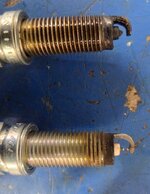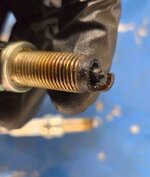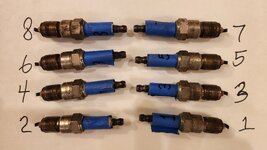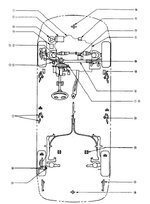That's a lot of codes!I bought the BlueDriver bluetooth dongle for $80, which provides a lot of information and I'm just beginning to look at it. It scanned my truck's computer system thoroughly and found additional errors I hadn't mentioned, like the A/C.
The BlueDriver youtube channel happens to have a playlist on this truck- what a happy coincidence! There's a video on the knock sensor and mass airflow sensor as well as the intake gasket, so I'm studying those.
God willing, I'll be working on it this week and making some posts. I'll try to live up to the @mountainaire documentation standard, haha.
View attachment 24276
View attachment 24277
View attachment 24278
View attachment 24279
You are using an out of date browser. It may not display this or other websites correctly.
You should upgrade or use an alternative browser.
You should upgrade or use an alternative browser.
DIY Car Maintenance
- Thread starter mountainaire
- Start date
Here are two short videos of a couple of scan tools from Autel so you can quickly see some of the differences in their features.
Autel AutoLink AL329 (Upgraded Ver. of AL319 MS309)
Autel Autolink AL439
Autel AutoLink AL329 (Upgraded Ver. of AL319 MS309)
Autel Autolink AL439
Attachments
Confirmed Codes
PO300
Random/Multiple Cylinder Misfire
Detected
>
P0332
Knock/Combustion Vibration Sensor
2 Circuit Low Bank 2
>
P0442
EVAP System Leak Detected (smal
leak)
>
PO446
EVAP System Vent Control Circuit
>
P0758
Shift Solenoid 'B' Electrical
>
P0894
Transmission Component Slipping
>
I am just reiterating what I've said before about these codes. Check those spark plugs and ignition coils. If you scanner allows to see a data lists that show misfire counter on all cylinders you maybe able to isolate which ones are misfiring. For example ( on a V6 engine) if cylinder 1,2, and 4 are misfiring you can plug and play by switching 1,2, and 4 ignition coils with 3,5, and 6 and see if the misfires follow the coils. Use a paint pen or a sharpie so you dont get confused putting them back. If you do get new coils it won't matter which way they go but for diagnostic purposes you wanna keep track which is which. Also check your spark plugs. You should be able to find your gap for your vehicle online and measure them. Also make sure they are not wet with oil. If they are you have more than likely have bad piston rings allowing oil to enter during the Otto cycle (combustion cycle aka, suck squeeze bang blow) where I work we usually recommend a new engine since its easier and less time consuming for ourselves and does save the customer money at the end of the day.
The vent control circuit is probably causing your evap leak small. I would replace the part and retest for the both codes.
Same for the transmission, you may just have a bad shift solenoid causing the slippage.
PO300
Random/Multiple Cylinder Misfire
Detected
>
P0332
Knock/Combustion Vibration Sensor
2 Circuit Low Bank 2
>
P0442
EVAP System Leak Detected (smal
leak)
>
PO446
EVAP System Vent Control Circuit
>
P0758
Shift Solenoid 'B' Electrical
>
P0894
Transmission Component Slipping
>
I am just reiterating what I've said before about these codes. Check those spark plugs and ignition coils. If you scanner allows to see a data lists that show misfire counter on all cylinders you maybe able to isolate which ones are misfiring. For example ( on a V6 engine) if cylinder 1,2, and 4 are misfiring you can plug and play by switching 1,2, and 4 ignition coils with 3,5, and 6 and see if the misfires follow the coils. Use a paint pen or a sharpie so you dont get confused putting them back. If you do get new coils it won't matter which way they go but for diagnostic purposes you wanna keep track which is which. Also check your spark plugs. You should be able to find your gap for your vehicle online and measure them. Also make sure they are not wet with oil. If they are you have more than likely have bad piston rings allowing oil to enter during the Otto cycle (combustion cycle aka, suck squeeze bang blow) where I work we usually recommend a new engine since its easier and less time consuming for ourselves and does save the customer money at the end of the day.
The vent control circuit is probably causing your evap leak small. I would replace the part and retest for the both codes.
Same for the transmission, you may just have a bad shift solenoid causing the slippage.
Interesting about the repair/replace advice. I can see that paying a shop to replace the engine is a better deal than paying for a rebuild. However, if you can do the rebuild yourself, it can save money and still give a good result. I have rebuilt several engines and got good power and long life from them after.Confirmed Codes
PO300
Random/Multiple Cylinder Misfire
Detected
>
P0332
Knock/Combustion Vibration Sensor
2 Circuit Low Bank 2
>
P0442
EVAP System Leak Detected (smal
leak)
>
PO446
EVAP System Vent Control Circuit
>
P0758
Shift Solenoid 'B' Electrical
>
P0894
Transmission Component Slipping
>
I am just reiterating what I've said before about these codes. Check those spark plugs and ignition coils. If you scanner allows to see a data lists that show misfire counter on all cylinders you maybe able to isolate which ones are misfiring. For example ( on a V6 engine) if cylinder 1,2, and 4 are misfiring you can plug and play by switching 1,2, and 4 ignition coils with 3,5, and 6 and see if the misfires follow the coils. Use a paint pen or a sharpie so you dont get confused putting them back. If you do get new coils it won't matter which way they go but for diagnostic purposes you wanna keep track which is which. Also check your spark plugs. You should be able to find your gap for your vehicle online and measure them. Also make sure they are not wet with oil. If they are you have more than likely have bad piston rings allowing oil to enter during the Otto cycle (combustion cycle aka, suck squeeze bang blow) where I work we usually recommend a new engine since its easier and less time consuming for ourselves and does save the customer money at the end of the day.
The vent control circuit is probably causing your evap leak small. I would replace the part and retest for the both codes.
Same for the transmission, you may just have a bad shift solenoid causing the slippage.
I had one 302 that such bad wear in the cylinder bores that they had to be bored .040 over, with new pistons and rings pressed onto existing rods. The crank also had to be ground .020 down, with new crank bearings. I put a truck cam in that engine and a turbo exhaust (plus straight pipe in place of the cat). Installed rebuilt cylinder heads as well. That truck really gained a lot of power, and I drove it for years as a work truck. I have fond memories of the project and of the truck.
Yes, in my father's hay day of automotive shop work re-ringing the pistons would be the ideal way to fix the issue and would have been given time to do it. Now we are expected to replace an engine and or transmission in about half a day which is not bad but not ideal. I've been hurried more working in dealerships that I was in the servicd.Interesting about the repair/replace advice. I can see that paying a shop to replace the engine is a better deal than paying for a rebuild. However, if you can do the rebuild yourself, it can save money and still give a good result. I have rebuilt several engines and got good power and long life from them after.
I had one 302 that such bad wear in the cylinder bores that they had to be bored .040 over, with new pistons and rings pressed onto existing rods. The crank also had to be ground .020 down, with new crank bearings. I put a truck cam in that engine and a turbo exhaust (plus straight pipe in place of the cat). Installed rebuilt cylinder heads as well. That truck really gained a lot of power, and I drove it for years as a work truck. I have fond memories of the project and of the truck.
@Read_Lives_of_Saints when you look at these spark plugs. The first photo shows an oil soaked spark plug (upper) and one that has been in an engine for 10 years. Second is just for reference.
Attachments
Helpful pics, thanks. I plan on changing the plugs first thing.@Read_Lives_of_Saints when you look at these spark plugs. The first photo shows an oil soaked spark plug (upper) and one that has been in an engine for 10 years. Second is just for reference.
Earlier today I used the BlueDriver app to clear all the codes, including the check engine (MIL) light, which is no longer on. I read that I need to drive the truck for a while, like 40 minutes at both low and high speed, in order for all of its self-diagnostics to check everything again and see which codes return, then after I change the plugs I'll see what's needed.
I'm expecting the knock sensor code to return and BlueDriver's youtube channel has a perfect video of how to replace it on this particular truck. You have to remove the intake manifold, so there are a lot of steps, but it's not too bad.
Since some of you are into Hondas and we all like to trouble-shoot car problems, here's a weird one that I ran into over 20 years ago with my 1998 Acura Integra GS-R. I'll write the symptoms and see if you can guess the cause and the fix, and then later I'll post the answer.
1998 Acura Integra GS-R
1.8L VTEC DOHC 170 HP engine inline 4-cylinder
5 Speed Manual Transmission
Front wheel drive
TL;DR
Acura Integra GS-R has wheel bearing replaced, next time on the highway there is a lot of heat emanating from the transmission tunnel, then the stereo head unit falls out.
Multiple thermometers show that the temperature at steering wheel level is 80°F but, when going over 60 MPH, the temperature rises to more than 130°F near the transmission tunnel between the seats.
The Acura dealership that replaced the wheel bearing under warranty reluctantly assigns a mechanic to investigate the symptoms and admits the intern who was helping with the wheel bearing removed the stereo head unit and did not reconnect it. The same mechanic, who at first could not find the heat problem, comes along for a drive and was shown that the temperature reading changed when the vehicle speed increased to 60, but he claims they're normal and refuses to investigate further.
When I told the symptoms to my friend, he meditated for two minutes and then crawled under the car with a flat head screwdriver and fixed the problem quickly.
LONG VERSION
I'd had the car for more than four years and knew how it performed under all weather and road conditions, which was perfectly, never running hot or cold from -25°F to 110°F. And suddenly one day, when I was distracted by my girlfriend and hit a hellatious pothole at low speed, the right front wheel bearing was toast.
The Integra was still under warranty, so I took it to the local Acura dealer where the service manager was friendly and helpful, and they replaced the bad bearing just before a week-long trip to the mountains for some car camping and day hiking with my girl and her dog.
It was the middle of the summer in one of the northern climes of the USA and, along the highway to the mountains, I noticed the car interior was much hotter than usual, even with the A/C on full blast, and it seemed like the heat was emanating from the transmission tunnel between the seats.
The next thing to go wrong was that on the dirt road to the campsite the stereo head unit completely fell out of the dashboard! In replacing and securing it with a piece of thick paper from a candy box, I noticed the head unit also had a deep scratch that was new and which I was certain could not have happened when it had fallen onto the gear shift boot.
When I returned to the city, I grabbed my Radio Shack indoor/outdoor, dual display thermometer that shows the temps from both sensors simultaneously, as well as a digital thermometer for HVAC pros that I used to confirm each of the other two readings. I hung one sensor in the air at steering wheel level and the other in the air near the transmission tunnel between the two front seats.
With the A/C on full blast and the ambient temp. around 85°F, the upper sensor read 80°F inside the car, which seemed a few degrees high, and the lower one was reading in the 130°'s. As I drove around, I discovered that the higher temps near the transmission tunnel began to increase with a very mild upward transition at 45 MPH, and then suddenly peaked once I hit 60 MPH.
I returned to the dealership and reported the problems to the same service manager, who was immediately incredulous about everything, especially the stereo, which he refused to inspect. He wanted to know if I had an alarm and if someone had tried to break in, so I told him I had a great alarm that had never been triggered and there was no evidence of a break-in. He continued to resist my request for service to this new problem that I said must have been caused by the wheel bearing repair, so I just kept repeating the symptoms and showing him my thermometers until he finally called a mechanic, to whom I explained everything again.
The mechanic agreed to look at the car and get back to me, which he did a day later, saying that he reconnected the head unit. He told me that an intern helper had disconnected the radio because he thought the wheel bearing job required it, and apparently he hadn't screwed everything back in. However, the mechanic couldn't find a problem with heat from the floor board, so I came over with my thermometers and we took a ride together in order for me to show him.
He was patient about driving at low and then high speeds and I showed him the readings, but he continued to deny the problem, so we switched places so that he could "operate" the thermometers himself. When he saw the readings and finally accepted them, he just said those were normal, so I asked if we could take the Integra they'd given me while mine was in the shop, but he refused and became unresponsive as I drove back to the dealership.
Failing to get help from the dealership, I was feeling vanquished and, in my frustration, I came too close to a parked pick-up truck with extended mirrors and knocked mine into his, causing the passenger mirror housing to swivel backward so violently that, when it reached its stop, the mirror lens popped out. Fortunately my passenger window was down and the mirror landed harmlessly in the seat and the housing wasn't even badly scratched. I tried for a few minutes to replace the lens, but I couldn't do it without feeling like I was about to break something, so I gave up.
Jarred back into reality, I suddenly remembered a friend who worked nearby and was mechanically gifted. His father was a major gear head and his son had inherited his skill partly from nature and partly from nurture. I found my buddy in his cubicle, wearing a suit and tie, and repairing a laptop. I told him my car had a problem just to see if he was interested and he immediately sprang up and came outside, where I explained all the symptoms. He closed his eyes and became still for almost two minutes until a large smile came across his face, then his eyes opened and he asked me for a flat head screwdriver, which I gave him as he crawled under my GS-R, not even bothering to remove his jacket.
I heard him underneath for a few minutes grunting and struggling with something and then he emerged with the same huge smile, his clothes perfectly clean and orderly, and he declared problem solved. Next, he noticed the mirror in my seat and I told him what happened, so he walked over, grabbed the lens and began massaging it back into the housing. In less than 10 seconds, it was good as new.
So what was the cause of the heat and how did my friend fix it?
1998 Acura Integra GS-R
1.8L VTEC DOHC 170 HP engine inline 4-cylinder
5 Speed Manual Transmission
Front wheel drive
TL;DR
Acura Integra GS-R has wheel bearing replaced, next time on the highway there is a lot of heat emanating from the transmission tunnel, then the stereo head unit falls out.
Multiple thermometers show that the temperature at steering wheel level is 80°F but, when going over 60 MPH, the temperature rises to more than 130°F near the transmission tunnel between the seats.
The Acura dealership that replaced the wheel bearing under warranty reluctantly assigns a mechanic to investigate the symptoms and admits the intern who was helping with the wheel bearing removed the stereo head unit and did not reconnect it. The same mechanic, who at first could not find the heat problem, comes along for a drive and was shown that the temperature reading changed when the vehicle speed increased to 60, but he claims they're normal and refuses to investigate further.
When I told the symptoms to my friend, he meditated for two minutes and then crawled under the car with a flat head screwdriver and fixed the problem quickly.
LONG VERSION
I'd had the car for more than four years and knew how it performed under all weather and road conditions, which was perfectly, never running hot or cold from -25°F to 110°F. And suddenly one day, when I was distracted by my girlfriend and hit a hellatious pothole at low speed, the right front wheel bearing was toast.
The Integra was still under warranty, so I took it to the local Acura dealer where the service manager was friendly and helpful, and they replaced the bad bearing just before a week-long trip to the mountains for some car camping and day hiking with my girl and her dog.
It was the middle of the summer in one of the northern climes of the USA and, along the highway to the mountains, I noticed the car interior was much hotter than usual, even with the A/C on full blast, and it seemed like the heat was emanating from the transmission tunnel between the seats.
The next thing to go wrong was that on the dirt road to the campsite the stereo head unit completely fell out of the dashboard! In replacing and securing it with a piece of thick paper from a candy box, I noticed the head unit also had a deep scratch that was new and which I was certain could not have happened when it had fallen onto the gear shift boot.
When I returned to the city, I grabbed my Radio Shack indoor/outdoor, dual display thermometer that shows the temps from both sensors simultaneously, as well as a digital thermometer for HVAC pros that I used to confirm each of the other two readings. I hung one sensor in the air at steering wheel level and the other in the air near the transmission tunnel between the two front seats.
With the A/C on full blast and the ambient temp. around 85°F, the upper sensor read 80°F inside the car, which seemed a few degrees high, and the lower one was reading in the 130°'s. As I drove around, I discovered that the higher temps near the transmission tunnel began to increase with a very mild upward transition at 45 MPH, and then suddenly peaked once I hit 60 MPH.
I returned to the dealership and reported the problems to the same service manager, who was immediately incredulous about everything, especially the stereo, which he refused to inspect. He wanted to know if I had an alarm and if someone had tried to break in, so I told him I had a great alarm that had never been triggered and there was no evidence of a break-in. He continued to resist my request for service to this new problem that I said must have been caused by the wheel bearing repair, so I just kept repeating the symptoms and showing him my thermometers until he finally called a mechanic, to whom I explained everything again.
The mechanic agreed to look at the car and get back to me, which he did a day later, saying that he reconnected the head unit. He told me that an intern helper had disconnected the radio because he thought the wheel bearing job required it, and apparently he hadn't screwed everything back in. However, the mechanic couldn't find a problem with heat from the floor board, so I came over with my thermometers and we took a ride together in order for me to show him.
He was patient about driving at low and then high speeds and I showed him the readings, but he continued to deny the problem, so we switched places so that he could "operate" the thermometers himself. When he saw the readings and finally accepted them, he just said those were normal, so I asked if we could take the Integra they'd given me while mine was in the shop, but he refused and became unresponsive as I drove back to the dealership.
Failing to get help from the dealership, I was feeling vanquished and, in my frustration, I came too close to a parked pick-up truck with extended mirrors and knocked mine into his, causing the passenger mirror housing to swivel backward so violently that, when it reached its stop, the mirror lens popped out. Fortunately my passenger window was down and the mirror landed harmlessly in the seat and the housing wasn't even badly scratched. I tried for a few minutes to replace the lens, but I couldn't do it without feeling like I was about to break something, so I gave up.
Jarred back into reality, I suddenly remembered a friend who worked nearby and was mechanically gifted. His father was a major gear head and his son had inherited his skill partly from nature and partly from nurture. I found my buddy in his cubicle, wearing a suit and tie, and repairing a laptop. I told him my car had a problem just to see if he was interested and he immediately sprang up and came outside, where I explained all the symptoms. He closed his eyes and became still for almost two minutes until a large smile came across his face, then his eyes opened and he asked me for a flat head screwdriver, which I gave him as he crawled under my GS-R, not even bothering to remove his jacket.
I heard him underneath for a few minutes grunting and struggling with something and then he emerged with the same huge smile, his clothes perfectly clean and orderly, and he declared problem solved. Next, he noticed the mirror in my seat and I told him what happened, so he walked over, grabbed the lens and began massaging it back into the housing. In less than 10 seconds, it was good as new.
So what was the cause of the heat and how did my friend fix it?
Helpful pics, thanks. I plan on changing the plugs first thing.
Earlier today I used the BlueDriver app to clear all the codes, including the check engine (MIL) light, which is no longer on. I read that I need to drive the truck for a while, like 40 minutes at both low and high speed, in order for all of its self-diagnostics to check everything again and see which codes return, then after I change the plugs I'll see what's needed.
I'm expecting the knock sensor code to return and BlueDriver's youtube channel has a perfect video of how to replace it on this particular truck. You have to remove the intake manifold, so there are a lot of steps, but it's not too bad.
After clearing the codes, I drove for an hour on surface streets and the freeway until, after some full throttle acceleration, the engine light came on and the knock sensor code was back. The misfire code is not back yet.
Looks like tomorrow I'll change the plugs and begin changing the knock sensors and intake manifold gaskets, which is recommended when doing the sensors. While only one knock sensor is tripping the code, it's a lengthy job, so I'll do both as they're not too expensive, about $50 each for mid-priced after market parts.

It's been over 30 years since I did any maintenance beyond oil changes and now there are so many different brands and price points that it's tough to choose something as simple as spark plugs.
Here's one web site with 20-30 different choices for knock sensors and intake manifold gaskets, and I haven't even checked the dealer.
I'm probably over thinking this, but do y'all have any recs on plugs and buying parts in general? Normally, I would just look at the range of prices and choose something in the middle, but I've been away from this topic for a long time and it's feeling weird.
Here's one web site with 20-30 different choices for knock sensors and intake manifold gaskets, and I haven't even checked the dealer.
I'm probably over thinking this, but do y'all have any recs on plugs and buying parts in general? Normally, I would just look at the range of prices and choose something in the middle, but I've been away from this topic for a long time and it's feeling weird.
For spark plugs always go with the brand and type spec'd from the factory. You should double check, but off the top of my head for your early 2000's 5.3 LS you'd want ACDelco platinum plugs, not double platinum or iridium, just regular standard single platinum. In my experience the stock ignition systems always work best with the plugs they came from the factory with, despite what all the marketing says.It's been over 30 years since I did any maintenance beyond oil changes and now there are so many different brands and price points that it's tough to choose something as simple as spark plugs.
Here's one web site with 20-30 different choices for knock sensors and intake manifold gaskets, and I haven't even checked the dealer.
I'm probably over thinking this, but do y'all have any recs on plugs and buying parts in general? Normally, I would just look at the range of prices and choose something in the middle, but I've been away from this topic for a long time and it's feeling weird.
Same goes for sensors. Go with the GM Genuine sensor on RockAuto. There are cheap ones that cost half what the GM sensor costs on there but I've had nothing but bad luck with cheap sensors. Avoid those like the plague, if they fail or don't work properly you'll have to do the job twice which is very frustrating.
For the gaskets I'd just pick whichever one is the best deal. I'd get this one because it comes with the plenum gaskets, the valley cover gasket, valve cover gaskets, a set of injector o-rings. The most important part about gaskets is proper installation. Make sure all mating surfaces are very clean, and make sure the fasteners are torqued correctly, to the correct values, and in sequence.
Last edited:
That's exactly what the kid in Auto Zone told me.For spark plugs always go with the brand and type spec'd from the factory. You should double check, but off the top of my head for your early 2000's 5.3 LS you'd want ACDelco platinum plugs, not double platinum or iridium, just regular standard single platinum. In my experience the stock ignition systems always work best with the plugs they came from the factory with, despite what all the marketing says.
That s great! Just the kind of tip I was looking for.Same goes for sensors. Go with the GM Genuine sensor on RockAuto. There are cheap ones that cost half what the GM sensor costs on there but I've had nothing but bad luck with cheap sensors. Avoid those like the plague, if they fail or don't work properly you'll have to do the job twice which is very frustrating.
For the gaskets I'd just pick whichever one is the best deal. I'd get this one because it comes with the plenum gaskets, the valley cover gasket, valve cover gaskets, a set of injector o-rings. The most important part about gaskets is proper installation. Make sure all mating surfaces are very clean, and make sure the fasteners are torqued correctly, to the correct values, and in sequence.
Very much appreciate you, Gazeebo, Thomas and even Francis
I removed the spark plugs and they look pretty good to me. They were all completely dry after sitting overnight. What do y'all think?
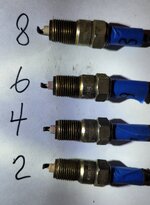
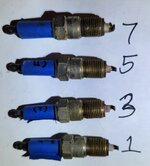
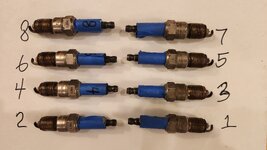
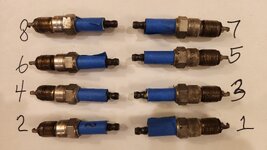
Trying to figure out which plugs are OEM has been difficult. The user manual says to go with iridium's that have been discontinued by ACDelco, which is what I just pulled out: GM part# 12571164 or AC Delco part# 41-985, but the current Chevy reference material says they should be double platinum ACDelco 41-962, which is what I bought. Either one is about $11 each x8.
One of the wires broke during removal so I'm going to replace them all. They're probably original, so after 21 years and 176K miles, it's probably a good idea. Apparently I need to match the wires to a number stamped on the coils. Here are some of the choices from Rock Auto.
After I removed them all, I got the idea that this is a good opportunity to do a compression test. Does it matter if I check each cylinder when all the spark plugs are out, as I'd rather not have to install each new one twice to do the test?




Trying to figure out which plugs are OEM has been difficult. The user manual says to go with iridium's that have been discontinued by ACDelco, which is what I just pulled out: GM part# 12571164 or AC Delco part# 41-985, but the current Chevy reference material says they should be double platinum ACDelco 41-962, which is what I bought. Either one is about $11 each x8.
One of the wires broke during removal so I'm going to replace them all. They're probably original, so after 21 years and 176K miles, it's probably a good idea. Apparently I need to match the wires to a number stamped on the coils. Here are some of the choices from Rock Auto.
After I removed them all, I got the idea that this is a good opportunity to do a compression test. Does it matter if I check each cylinder when all the spark plugs are out, as I'd rather not have to install each new one twice to do the test?
Attachments
I removed the spark plugs and they look pretty good to me. They were all completely dry after sitting overnight. What do y'all think?
View attachment 24464
View attachment 24465
View attachment 24462
View attachment 24463
Trying to figure out which plugs are OEM has been difficult. The user manual says to go with iridium's that have been discontinued by ACDelco, which is what I just pulled out: GM part# 12571164 or AC Delco part# 41-985, but the current Chevy reference material says they should be double platinum ACDelco 41-962, which is what I bought. Either one is about $11 each x8.
One of the wires broke during removal so I'm going to replace them all. They're probably original, so after 21 years and 176K miles, it's probably a good idea. Apparently I need to match the wires to a number stamped on the coils. Here are some of the choices from Rock Auto.
After I removed them all, I got the idea that this is a good opportunity to do a compression test. Does it matter if I check each cylinder when all the spark plugs are out, as I'd rather not have to install each new one twice to do the test?
For a compression test, I like to leave all plugs out so the starter can turn the engine over more easily. Disable the fuel pump before doing the compression test by pulling the fuse. You'll want to keep the throttle open while cranking for consistent readings.
Helps to have another person work the key while you work the gauge. If help isn't available, you can make a jumper wire that goes into the starter relay socket to activate the starter while holding the gauge under the hood.
The answer to the question that nobody asked for.Since some of you are into Hondas and we all like to trouble-shoot car problems, here's a weird one that I ran into over 20 years ago with my 1998 Acura Integra GS-R. I'll write the symptoms and see if you can guess the cause and the fix, and then later I'll post the answer.
1998 Acura Integra GS-R
1.8L VTEC DOHC 170 HP engine inline 4-cylinder
5 Speed Manual Transmission
Front wheel drive
TL;DR
Acura Integra GS-R has wheel bearing replaced, next time on the highway there is a lot of heat emanating from the transmission tunnel, then the stereo head unit falls out.
Multiple thermometers show that the temperature at steering wheel level is 80°F but, when going over 60 MPH, the temperature rises to more than 130°F near the transmission tunnel between the seats.
The Acura dealership that replaced the wheel bearing under warranty reluctantly assigns a mechanic to investigate the symptoms and admits the intern who was helping with the wheel bearing removed the stereo head unit and did not reconnect it. The same mechanic, who at first could not find the heat problem, comes along for a drive and was shown that the temperature reading changed when the vehicle speed increased to 60, but he claims they're normal and refuses to investigate further.
When I told the symptoms to my friend, he meditated for two minutes and then crawled under the car with a flat head screwdriver and fixed the problem quickly.
LONG VERSION
I'd had the car for more than four years and knew how it performed under all weather and road conditions, which was perfectly, never running hot or cold from -25°F to 110°F. And suddenly one day, when I was distracted by my girlfriend and hit a hellatious pothole at low speed, the right front wheel bearing was toast.
The Integra was still under warranty, so I took it to the local Acura dealer where the service manager was friendly and helpful, and they replaced the bad bearing just before a week-long trip to the mountains for some car camping and day hiking with my girl and her dog.
It was the middle of the summer in one of the northern climes of the USA and, along the highway to the mountains, I noticed the car interior was much hotter than usual, even with the A/C on full blast, and it seemed like the heat was emanating from the transmission tunnel between the seats.
The next thing to go wrong was that on the dirt road to the campsite the stereo head unit completely fell out of the dashboard! In replacing and securing it with a piece of thick paper from a candy box, I noticed the head unit also had a deep scratch that was new and which I was certain could not have happened when it had fallen onto the gear shift boot.
When I returned to the city, I grabbed my Radio Shack indoor/outdoor, dual display thermometer that shows the temps from both sensors simultaneously, as well as a digital thermometer for HVAC pros that I used to confirm each of the other two readings. I hung one sensor in the air at steering wheel level and the other in the air near the transmission tunnel between the two front seats.
With the A/C on full blast and the ambient temp. around 85°F, the upper sensor read 80°F inside the car, which seemed a few degrees high, and the lower one was reading in the 130°'s. As I drove around, I discovered that the higher temps near the transmission tunnel began to increase with a very mild upward transition at 45 MPH, and then suddenly peaked once I hit 60 MPH.
I returned to the dealership and reported the problems to the same service manager, who was immediately incredulous about everything, especially the stereo, which he refused to inspect. He wanted to know if I had an alarm and if someone had tried to break in, so I told him I had a great alarm that had never been triggered and there was no evidence of a break-in. He continued to resist my request for service to this new problem that I said must have been caused by the wheel bearing repair, so I just kept repeating the symptoms and showing him my thermometers until he finally called a mechanic, to whom I explained everything again.
The mechanic agreed to look at the car and get back to me, which he did a day later, saying that he reconnected the head unit. He told me that an intern helper had disconnected the radio because he thought the wheel bearing job required it, and apparently he hadn't screwed everything back in. However, the mechanic couldn't find a problem with heat from the floor board, so I came over with my thermometers and we took a ride together in order for me to show him.
He was patient about driving at low and then high speeds and I showed him the readings, but he continued to deny the problem, so we switched places so that he could "operate" the thermometers himself. When he saw the readings and finally accepted them, he just said those were normal, so I asked if we could take the Integra they'd given me while mine was in the shop, but he refused and became unresponsive as I drove back to the dealership.
Failing to get help from the dealership, I was feeling vanquished and, in my frustration, I came too close to a parked pick-up truck with extended mirrors and knocked mine into his, causing the passenger mirror housing to swivel backward so violently that, when it reached its stop, the mirror lens popped out. Fortunately my passenger window was down and the mirror landed harmlessly in the seat and the housing wasn't even badly scratched. I tried for a few minutes to replace the lens, but I couldn't do it without feeling like I was about to break something, so I gave up.
Jarred back into reality, I suddenly remembered a friend who worked nearby and was mechanically gifted. His father was a major gear head and his son had inherited his skill partly from nature and partly from nurture. I found my buddy in his cubicle, wearing a suit and tie, and repairing a laptop. I told him my car had a problem just to see if he was interested and he immediately sprang up and came outside, where I explained all the symptoms. He closed his eyes and became still for almost two minutes until a large smile came across his face, then his eyes opened and he asked me for a flat head screwdriver, which I gave him as he crawled under my GS-R, not even bothering to remove his jacket.
I heard him underneath for a few minutes grunting and struggling with something and then he emerged with the same huge smile, his clothes perfectly clean and orderly, and he declared problem solved. Next, he noticed the mirror in my seat and I told him what happened, so he walked over, grabbed the lens and began massaging it back into the housing. In less than 10 seconds, it was good as new.
So what was the cause of the heat and how did my friend fix it?
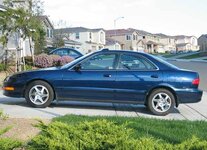
Apparently when you change the passenger side front wheel bearing in this car, you have to disconnect the drive shaft, which requires disconnecting the shift lever linkage, which attaches to the transaxle, sitting directly behind the exhaust system, somewhere around #5 in the diagram.
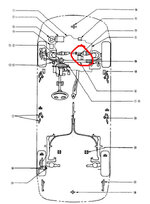
There is a kind of access tube to the shift lever that has a large rubber gasket covering it in order to prevent water and other things, like exhaust gases, from going up there into the tunnel and the shift lever boot.
Because of its aerodynamics, those exhaust gases are only hot enough and flowing just the right way to go through that gap and into the tunnel when the vehicle's ground speed reaches 60 MPH.
Somehow, without having ever owned a front-wheel drive vehicle or having ever worked on mine before, my friend figured this all out and crawled under the car with a flat head screwdriver, then moved the partially installed gasket into its correct position.
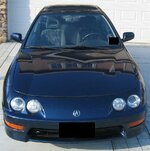
Attachments
That is amazing!The answer to the question that nobody asked for.
View attachment 24694
Apparently when you change the passenger side front wheel bearing in this car, you have to disconnect the drive shaft, which requires disconnecting the shift lever linkage, which attaches to the transaxle, sitting directly behind the exhaust system, somewhere around #5 in the diagram.
View attachment 24697
There is a kind of access tube to the shift lever that has a large rubber gasket covering it in order to prevent water and other things, like exhaust gases, from going up there into the tunnel and the shift lever boot.
Because of its aerodynamics, those exhaust gases are only hot enough and flowing just the right way to go through that gap and into the tunnel when the vehicle's ground speed reaches 60 MPH.
Somehow, without having ever owned a front-wheel drive vehicle or having ever worked on mine before, my friend figured this all out and crawled under the car with a flat head screwdriver, then moved the partially installed gasket into its correct position.
View attachment 24696
My friend should have been a professional mechanic. He's an absolute genius at it, but his dad talked him into becoming some kind of financial analyst, which he hated.That is amazing!
That reminds me of the movie Office Space, where the main characters ended up happier doing manual labor than they were in a software company. I've done electrical and mechanical maintenance and installation, and I've done software and engineering. There really are some advantages to a job where you do physical labor and don't have to take your work home with you.My friend should have been a professional mechanic. He's an absolute genius at it, but his dad talked him into becoming some kind of financial analyst, which he hated.
I said exhaust gases, but I meant the ambient air flowing past the exhaust system and being heated.There is a kind of access tube to the shift lever that has a large rubber gasket covering it in order to prevent water and other things, like exhaust gases, from going up there into the tunnel and the shift lever boot.
Because of its aerodynamics, those exhaust gases are only hot enough and flowing just the right way to go through that gap and into the tunnel when the vehicle's ground speed reaches 60 MPH.
Amazing. I am always in admiration of guys that can do that kind of deduction.The answer to the question that nobody asked for.
View attachment 24694
Apparently when you change the passenger side front wheel bearing in this car, you have to disconnect the drive shaft, which requires disconnecting the shift lever linkage, which attaches to the transaxle, sitting directly behind the exhaust system, somewhere around #5 in the diagram.
View attachment 24697
There is a kind of access tube to the shift lever that has a large rubber gasket covering it in order to prevent water and other things, like exhaust gases, from going up there into the tunnel and the shift lever boot.
Because of its aerodynamics, those exhaust gases are only hot enough and flowing just the right way to go through that gap and into the tunnel when the vehicle's ground speed reaches 60 MPH.
Somehow, without having ever owned a front-wheel drive vehicle or having ever worked on mine before, my friend figured this all out and crawled under the car with a flat head screwdriver, then moved the partially installed gasket into its correct position.
View attachment 24696
Also, a great example of "simplest answer is usually the right one"

